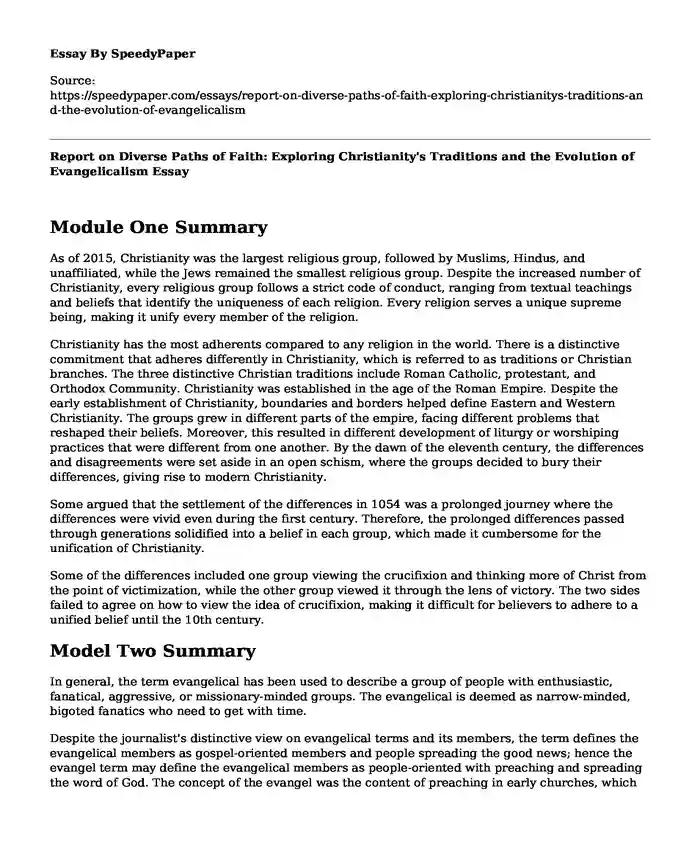
| Type of paper: | Essay |
| Categories: | Religion Christianity Community |
| Pages: | 3 |
| Wordcount: | 577 words |
Module One Summary
As of 2015, Christianity was the largest religious group, followed by Muslims, Hindus, and unaffiliated, while the Jews remained the smallest religious group. Despite the increased number of Christianity, every religious group follows a strict code of conduct, ranging from textual teachings and beliefs that identify the uniqueness of each religion. Every religion serves a unique supreme being, making it unify every member of the religion.
Christianity has the most adherents compared to any religion in the world. There is a distinctive commitment that adheres differently in Christianity, which is referred to as traditions or Christian branches. The three distinctive Christian traditions include Roman Catholic, protestant, and Orthodox Community. Christianity was established in the age of the Roman Empire. Despite the early establishment of Christianity, boundaries and borders helped define Eastern and Western Christianity. The groups grew in different parts of the empire, facing different problems that reshaped their beliefs. Moreover, this resulted in different development of liturgy or worshiping practices that were different from one another. By the dawn of the eleventh century, the differences and disagreements were set aside in an open schism, where the groups decided to bury their differences, giving rise to modern Christianity.
Some argued that the settlement of the differences in 1054 was a prolonged journey where the differences were vivid even during the first century. Therefore, the prolonged differences passed through generations solidified into a belief in each group, which made it cumbersome for the unification of Christianity.
Some of the differences included one group viewing the crucifixion and thinking more of Christ from the point of victimization, while the other group viewed it through the lens of victory. The two sides failed to agree on how to view the idea of crucifixion, making it difficult for believers to adhere to a unified belief until the 10th century.
Model Two Summary
In general, the term evangelical has been used to describe a group of people with enthusiastic, fanatical, aggressive, or missionary-minded groups. The evangelical is deemed as narrow-minded, bigoted fanatics who need to get with time.
Despite the journalist's distinctive view on evangelical terms and its members, the term defines the evangelical members as gospel-oriented members and people spreading the good news; hence the evangel term may define the evangelical members as people-oriented with preaching and spreading the word of God. The concept of the evangel was the content of preaching in early churches, which centered its teaching on the proclamation of life, death, and the resurrection of Jesus Christ.
During the sixteenth century, the Protestant Reformation emanated in Western Europe, which laid the foundation for all protestant groups, including the evangelicals. On the contrary, the Evangelical groups have been connected to Anglicanism in many regions of the world, especially in the United States, where the Anglican Church is referred to as the Episcopal Church.
Evangelistically, the concept has also been widely associated with post-fundamentalism, where numerous members had sensed a rift between the increasing militant fundamentalism that was observed in the 1920s, and 1930s. As a result, this ushered in the concept of post-fundamentalist evangelicalism. However, despite the rift, there is no distinctive drawing line that is dividing the older fundamentalism from the newer evangelism. The Post- fundamentalists, have a similar theological orientation compared to the pre-Scopes trial fundamentalist. However, they tend to distance themselves from that connection, since the term "fundamentalist" had turned out to be an embarrassment, rather than being deemed as a badge of honor.
Cite this page
Report on Diverse Paths of Faith: Exploring Christianity's Traditions and the Evolution of Evangelicalism. (2023, Dec 19). Retrieved from https://speedypaper.com/essays/report-on-diverse-paths-of-faith-exploring-christianitys-traditions-and-the-evolution-of-evangelicalism
Request Removal
If you are the original author of this essay and no longer wish to have it published on the SpeedyPaper website, please click below to request its removal:
- Islamic Perspective on Euthanasia, Free Essay Sample
- Religion Essay Sample: The Similarities and Differences between the Sunni and Shiite Muslims
- Paper Example on Modern Moral Philosophy
- Free Essay: How Social Workers Shape Policies and How They Identify Harmful Policies
- Free Essay. High Middle Ages
- Free Paper on Media and Affirmative Action: Influencing Equality for Minority Groups
- Impact of Christ on the Modern World - Essay Sample
Popular categories




